Mostrar el registro sencillo del ítem
dc.contributor.author
Petersen, Gitte
dc.contributor.author
Aagesen, Lone

dc.contributor.author
Seberg, Ole
dc.contributor.author
Larsen, Ida Hartvig
dc.date.available
2019-01-24T19:16:01Z
dc.date.issued
2011-08
dc.identifier.citation
Petersen, Gitte; Aagesen, Lone; Seberg, Ole; Larsen, Ida Hartvig; When is enough, enough in phylogenetics? A case in point from Hordeum (Poaceae); Wiley Blackwell Publishing, Inc; Cladistics; 27; 4; 8-2011; 428-446
dc.identifier.issn
0748-3007
dc.identifier.uri
http://hdl.handle.net/11336/68534
dc.description.abstract
Direct optimization was used to reconstruct the phylogeny of the 26 diploid taxa included in the genus Hordeum. The total data set was composed of 16 nucleotide sequence regions from the nuclear as well as the plastid genome. The nine nuclear regions were from single-copy, protein coding genes located on six of the seven chromosome pairs in the diploid H. vulgare genome. The seven plastid regions comprise protein coding genes as well as intergenic regions. Studies of character congruence between data partitions showed no correlation between chromosomal location and congruence among the nuclear sequences and a level of congruence among the plastid sequences comparable with the level among the nuclear sequences. Combined analysis of all data resolved the phylogeny completely with most clades being robust and well supported. However, due to incongruence among data partitions some relationships are still and likely to remain ambiguously inferred. Rather than adding still more genes to the phylogenetic analyses, patterns of incongruence may be better explored by adding data from multiple specimens per taxon. For some species relationships the plastid data appear positively misleading, emphasizing the need for caution if plastid data are the only or dominant type of data used for phylogenetic reconstruction and subsequent re-classification.
dc.format
application/pdf
dc.language.iso
eng
dc.publisher
Wiley Blackwell Publishing, Inc

dc.rights
info:eu-repo/semantics/openAccess
dc.rights.uri
https://creativecommons.org/licenses/by-nc-sa/2.5/ar/
dc.subject
Phylogeny
dc.subject
Hordeum
dc.subject
Direct Optimization
dc.subject.classification
Otras Ciencias Biológicas

dc.subject.classification
Ciencias Biológicas

dc.subject.classification
CIENCIAS NATURALES Y EXACTAS

dc.title
When is enough, enough in phylogenetics? A case in point from Hordeum (Poaceae)
dc.type
info:eu-repo/semantics/article
dc.type
info:ar-repo/semantics/artículo
dc.type
info:eu-repo/semantics/publishedVersion
dc.date.updated
2019-01-24T18:47:54Z
dc.journal.volume
27
dc.journal.number
4
dc.journal.pagination
428-446
dc.journal.pais
Reino Unido

dc.journal.ciudad
Londres
dc.description.fil
Fil: Petersen, Gitte. Natural History Museum of Copenhague; Dinamarca. Universidad de Copenhagen; Dinamarca
dc.description.fil
Fil: Aagesen, Lone. Consejo Nacional de Investigaciones Científicas y Técnicas. Instituto de Botánica Darwinion. Academia Nacional de Ciencias Exactas, Físicas y Naturales. Instituto de Botánica Darwinion; Argentina
dc.description.fil
Fil: Seberg, Ole. Natural History Museum of Copenhague; Dinamarca. Universidad de Copenhagen; Dinamarca
dc.description.fil
Fil: Larsen, Ida Hartvig. Natural History Museum of Copenhague; Dinamarca. Universidad de Copenhagen; Dinamarca
dc.journal.title
Cladistics

dc.relation.alternativeid
info:eu-repo/semantics/altIdentifier/doi/http://dx.doi.org/10.1111/j.1096-0031.2011.00347.x
dc.relation.alternativeid
info:eu-repo/semantics/altIdentifier/url/https://onlinelibrary.wiley.com/doi/abs/10.1111/j.1096-0031.2011.00347.x
Archivos asociados
